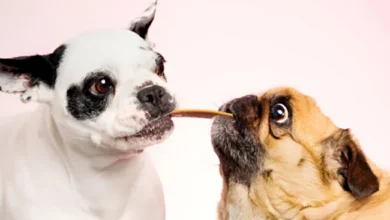Fall in Love with Pomskies – The Adorable Crossbreed of Huskies and Pomeranians
From their fluffy coats to their friendly personalities, there's a lot to love about Pomskies.

MixbreedDogs.com is an Amazon Associate, and we earn from qualifying purchases.
If you’ve heard the term “Pomsky” and have done a Google search any time recently, then you know how great this mixed breed dog looks. Only a mix of Pomeranian and Husky could result in this extraordinary mixed breed dog.
Pomskies are relatively new in the world of designer dog breeds, but it’s understandable why they are gaining so much popularity. They look exactly like the dog you always dreamed of having. And the Pomsky puppies… they are absolute heartbreakers!
However, these qualities in and of themselves are not enough to just bring a Pomsky dog home. There are quite a few things you need to know about the breed before deciding whether or not this breed is right for you.
MixBreedDogs presents a complete guide to Pomskies (a.k.a. Pomeranian Husky Mix). In this guide, we will discuss the physical and behavioral characteristics of the dog, along with its temperament, health and training potential.
Let’s start with some basic information.
Origins of a Pomsky
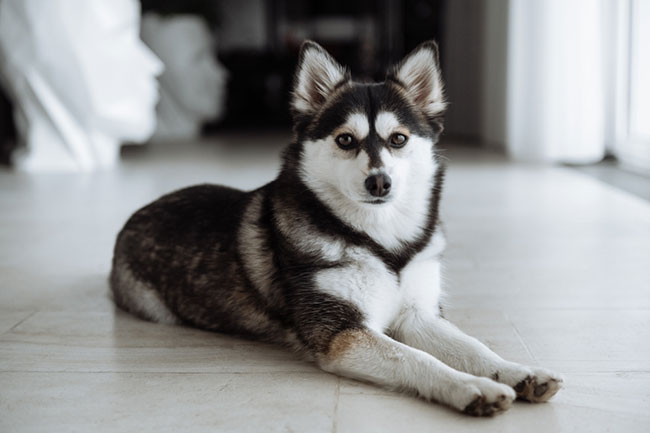
To understand the origins of a Pomsky, we need to take a look at the origins of both the parent breeds. The genes, passed through their parents, hold the key to the history of the breed.
It’s important for any potential Pomsky owner to understand where this mixed breed comes from. Later this history is used to uncover their personality, temperament, health concerns and a lot more.
Origins of Pomeranian
Modern Pomeranians are the miniature versions of a powerful spitz-type Arctic sled dog. They were named after Pomerania, an area which is now a part of Poland and West Germany.
They are also known as “Zwergspitz” because they are the smallest of the Spitz breeds. Their elegant, regal appearance caught the attention of Queen Victoria. She became smitten with Poms, which according to her were “fit for a queen”.
Queen Victoria heavily invested in the breeding of Poms and at the 1891 Crufts Dog Show, one of her favorites, Windsor Marco, won the top spot. She was also responsible for reducing their size by 30 pounds and ushering them into their current toy stature.
Poms have been faithful companions to many sophisticated people throughout history such as Emile Zola, Marie Antoinette, and Wolfgang Amadeus Mozart.
Origins of Siberian Husky
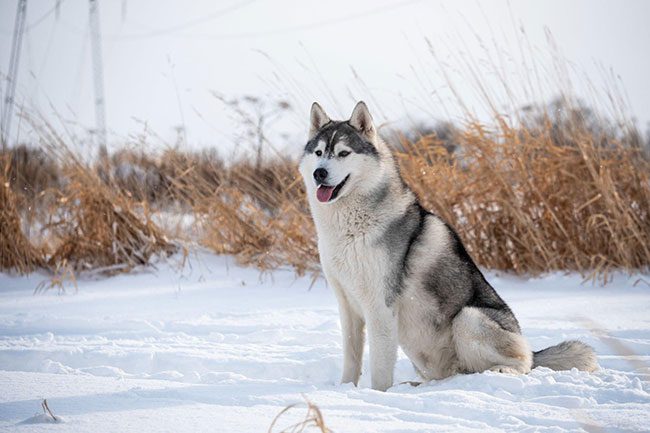
Siberian Huskies were bred by the nomadic Chukchi people as companion dogs and for pulling sleds. They were perfect to work and survive the sub-zero temperatures of North East Siberia.
Known to be one of the oldest purebred dogs in the world, they only came into focus in the early years of the 19th century.
Check out a more detailed history of the Siberian Huskies here.
Physical Characteristics of a Pomsky

When it comes to crossbreeds, the puppy is set to inherit characteristics from both parents. However, no two puppies are the same—even in the same litter; it’s not unusual when they heavily take of features from any one parent.
Size and Weight
Many potential Pomsky owners have asked, “How big is a full grown Pomsky?” Well, in short, there is no way to tell how big a Pomsky puppy will grow to be.
Generally, a full grown Pomsky weighs between 20-30 pounds (9-14 kg) and can grow up to 10-15 inches (25-38 cm) in height. The huge difference is mostly because of how different the two breeds are.
Pomeranians weigh up to 7 pounds and grow a maximum of 12 inches, whereas Huskies, on the other hand, can grow up to 23 inches and weigh up to 60 pounds.
Appearance and Color
Breeders are trying to keep Pomskies at a toy level. They are much cuter that way. It’s one of the primary reasons why this breed is suddenly becoming popular. The thought of a pocked-sized husky melts even the coldest of hearts.
They retain the spitz-like traits such as pointy ears, a fox-like face, and a thick, curly coat.
Many look for Pomskies with husky-like markings. But they are also found in black, gray, brown, cream and red colorings. Their markings varied between partial, sable and solid.
Related Reads: Complete Guide To Husky Pitbull Mix Breed Dog
Personality and Temperament of a Pomsky
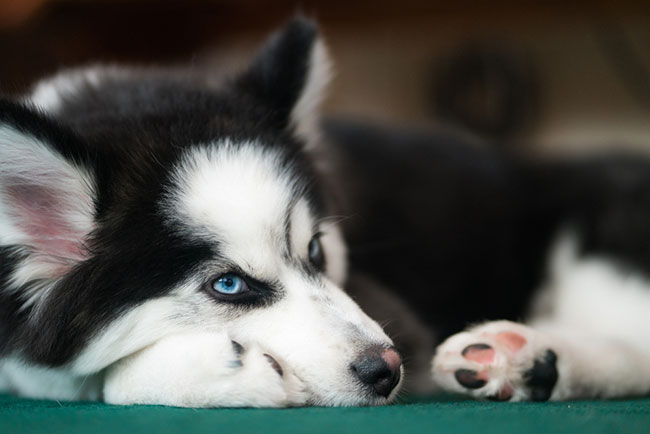
It’s often hard to deduce how a crossbreed dog will turn out—a Pomsky is no different. With Husky and Pomeranian parents, this mixed breed can be expected to be intelligent, very energetic, loving, and extroverted.
In addition to being friendly and loyal, they retain their attention-seeking traits and will get into mischief if not looked after properly. They are very protective of their owners an make excellent guard dogs.
However, there are some Pomsky behavior traits you do need to watch out for. They can be very possessive to the extreme and may lash out aggressively or exhibit small dog syndrome. Thankfully, both can be controlled through training.
Pomskies are known for their sharp barks. This behavior depends on the genetic makeup of the dog and may or may not show up in every Pomsky dog.
Related Reads: Pocket Pitbulls: Everything You Want to Know About
Trainability of a Pomsky
Pomskies are intelligent, which means that if they are not trained properly, they will cause trouble. Shortly after the puppy is properly vaccinated and brought home, they should start basic training.
No matter what happens, you must establish yourself as the alpha when training a Pomsky puppy. If not, they will be difficult to handle. You might consider crate training and leash training in addition to their regular training.
Intelligent dogs like Pomskies will get bored easily. That means you will need to provide the dog with enough mental and physical exercise to keep them entertained.
Remember, a bored Pomsky is a sad Pomsky. They will act out negatively and resort to chewing and excessive barking. In worse cases, a bored Pomsky will dig under and jump fences in order to escape. So, getting an electric dog fence might also be a good idea.
Related Reads: Complete Guide To Beagle Pitbull Mix Breed Dog
Health Concerns of a Pomsky
The Pomsky breed is very recent and there not much information known about their health conditions. Although mixed breeds are generally healthier than purebred dogs, some hereditary problems remain.
Siberian Huskies mostly suffer from degenerative eye and skin conditions. In addition, they may have corneal dystrophy, uveodermatologic syndrome, follicular dysplasia, or a zinc deficiency, all of which are common health concerns for this nomadic breed.
Like Huskies, Pomeranians are also a healthy breed. However, they are mostly at risk of obesity and teeth and gum problems. They also suffer from hypoglycemia, patellar luxation, tracheal collapse, distichiasis, and entropion.
It’s unsure which health problems the Pomsky will inherit. Your breeder should provide you with a complete health history, based on the health of the Pomsky’s parents.
General health concerns like joint problems are also a concern, but a Pomsky which has been properly taken care of can live between 13 and 15 years.
Related Reads:
Complete Guide To German Shepherd Border Collie Mix Breed Dog
Taking Care of a Pomsky
Bringing a dog home is a huge responsibility and that responsibility ten folds with a dog like a Pomsky. This is a controversial breed, so you’ll need to do a lot of homework to learn as much as you can about this breed.
In addition, you need to be prepared mentally, physically and financially to support your Pomsky.
Exercise
With Pomeranian and Husky parents, it’s likely that a Pomsky will be very energetic. They are totally unsuitable for people with any variation of “couch potato syndrome”. They need to be exercised every day.
Huskies love the outdoors, and so do Pomskies. Go for a run, a long walk, or a swim—take your Pomsky with you.
As stated previously, a bored Pomsky will develop destructive behaviors which can be hard to control. Invest in some good chew toys and dog puzzles to keep them stimulated mentally.
Grooming
It’s a good practice to start grooming your Pomsky at an early age. This gives both of you an opportunity to establish a sense of trust.
Pomskies are blessed with a wonderful shiny coat which needs constant brushing. The shiny coat is mostly inherited from their Pomeranian parent and will require brushing 3-5 times a week.
Another part of grooming is shedding. Pomskies shed 2 times a year, especially during warmer seasons. Their shedding can last up to 90 days.
To combat all the dog hair, investing in a good vacuum cleaner is highly recommended. If you want to save some money in the long run, get a heavy-duty dog hair clipper.
Keep in mind that grooming includes taking proper care of their teeth and nails and making sure your Pomsky is flea-free.
Nutrition
As an energetic dog, it’s essential that you provide your Pomsky with a healthy, balanced and nutritious diet. Some owners are happy with making homemade dog food. If you are unable to do that, make sure to give them a high-protein diet so that they can maintain their energetic lifestyle.
The food should be measured and given at scheduled times. Overeating can cause many health problems such as diabetes or worse. Go for nutritious ingredients such as white rice, chicken breast, and fish.
Always consult your veterinarian before switching to the new food. And if your dog maintains good behavior, reward him with low-fat treats!
Cost
Unlike other dogs, maintaining a Pomsky is expensive. Designer dogs, especially new ones like Pomsky puppies, tend to be sold anywhere from $1,000 to $5,000. The geographical location and physical markings also can impact the cost. The first pick of the litter will cost you an extra $100 to $500.
Toys and accessories will cost you another $430 and if you want your dog to be housebroken and obedient, the cost of a trainer cost will vary depending on their time and skills.
Then comes the cost of grooming. After determining your Pomsky’s type of coat, a professional groomer can charge from $30 to $90 for a standard cut. Additional services will cost extra.
If you’re busy and away from home a lot, you’ll have to put your Pomsky in daycare or risk your fine leather couch and other valuables being destroyed. That will deduct another $240 to $500 on a monthly basis. Dog walkers charge typically charge anywhere from $15 to $30 on average for a half hour walk. Prices tend to go up in the city.
Dog kibble and treats will cost around $460 per year.
And finally, even if your Pomsky is healthy, you will need to pay the least of $390 for preventative medication and $200 to $700 in pet insurance. The vaccinations will naturally cost extra.
Factoring in other miscellaneous expenses, you’ll spend a minimum of $2,500 yearly on your Pomsky. We aren’t trying to scare you—we’re just being realistic.
Related Posts:
Buying a Pomsky Puppy
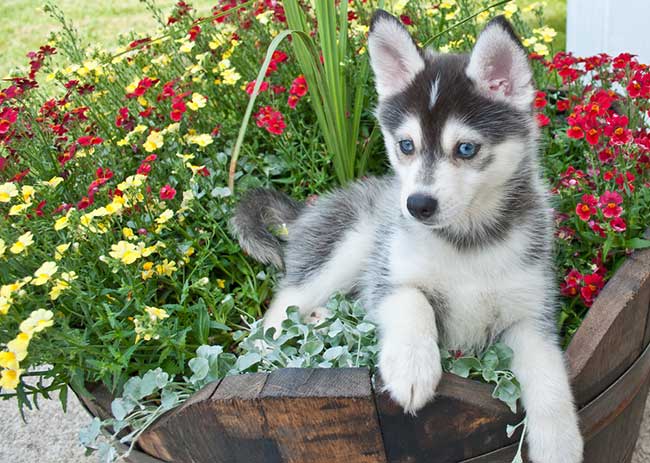
If you’ve decided to get a Pomsky, then the logical next step is to find a reputable breeder. All dogs, especially crossbreds like Pomkies, Pitskies, etc. should come from a reputable breeder.
The reason is fairly simple—mixed breed dogs don’t have an official standard, so it’s very easy for irresponsible breeders to scam you. Always buy from a person who prioritizes the dog’s health before personal profit.
There are organizations such as The Pomsky Club of America or The International Pomsky Association who can locate a responsible breeder in your area.
Here are a few pro tips that might help:
Ask Questions:
You should ask any questions you have in mind related to Pomskies. If you’re shy and avoid asking questions, you’ll be missing out.
Get photos and videos:
Ask your breeder for pictures and videos of your puppy. If you’re still concerned about the authenticity, video chat in real time to see the puppies.
Get references and testimonials:
The best way to avoid a scam is to get a good reference from someone close to you. No reference, no deal!
Know the right prices:
Knowing the right prices will ensure you aren’t cheated out of your money. Generally, Pomskies with Husky-like features are in high demand and may cost more. Compare with other breeders.
Is your breeder registered?:
Registered breeders will always have proper documentation about what they are selling. They’ll have a detailed history of the parents and will not hesitate to show them to you.
Get a sales contract:
A proper breeder will always provide documentation or a sales contract that guarantees ethical breeding practices.
These tips will save you from buying a fake, sick or overly expensive Pomsky puppy.
Related Reads: Complete Guide To German Shepherd Pitbull Mix
Related Posts:
Recognition
The Pomsky is a rising star in the world of designer dogs. It’s sad that they aren’t recognized by the American Kennel Club. Several canine clubs like The Dog Registry of America Inc., The International Pomsky Association and The Pomsky Club of America have already officially recognized this breed.
Related Reads: Everything You Need to Know About the Blue Nose Pitbull
Conclusion
By now, you must feel overwhelmed with all of this information. A simple solution is to take a deep breath and go through it again.
Owning a Pomsky puppy will test your patience more than once, but in return, you’ll get an intelligent, energetic and loyal dog like no other… not to mention, unbelievably cute.
All the controversies, unpredictability and difficulties won’t matter once you’ve made your decision. Trust your instincts, and follow your heart.
Share your opinions below!


